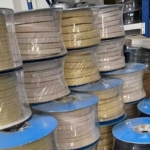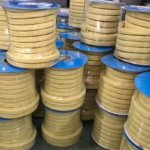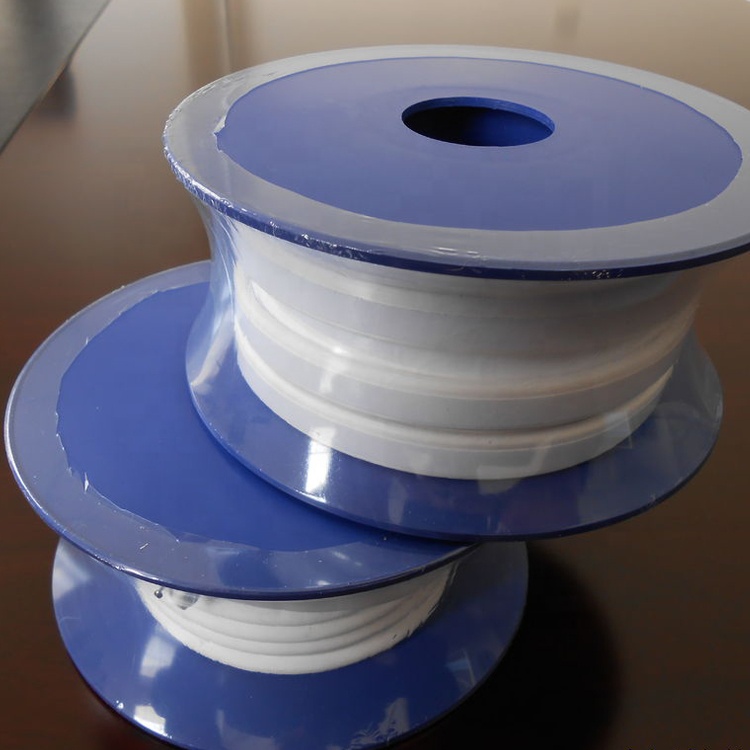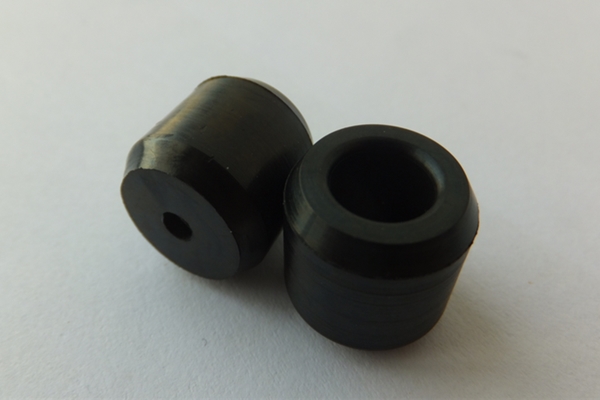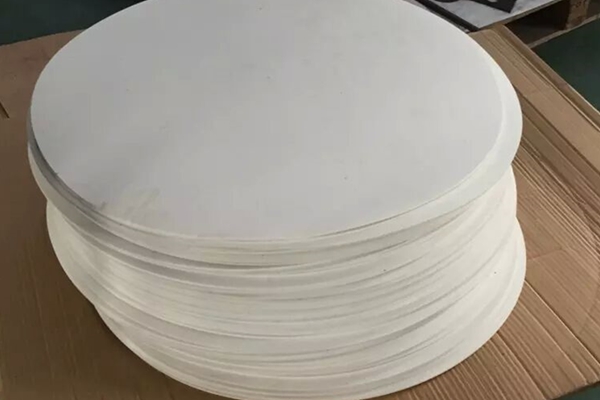The PTFE braided packing is made from woven polytetrafluoroethylene (PTFE) fibers and possesses excellent flexibility and corrosion resistance. It maintains PTFE strength in high-temperature and humid environments and is easy to install and remove. PTFE braided packing can be categorized into the following types when mixed with other fibers:
- Pure PTFE braided packing: It is made by twisting and weaving 100% oil-free PTFE flat yarn, without added lubricants. This ensures the purity and flexibility of the PTFE braided packing and is mainly used in static seals that require high media purity low-pressure valves and low-speed applications. It is widely used in industries such as food, pharmaceuticals, papermaking, and textiles.
- Oil PTFE braided packing: This type is woven from pure PTFE yarn and treated with special lubricating silicon oil, providing better lubrication and friction coefficients. It expands the application range of oil-free PTFE braided packing to higher linear speeds. It can be used in industries where contamination is not allowed, such as the food, pharmaceutical, papermaking, chemical, and fine chemical industries.
- Aramid corner PTFE braided packing: It utilizes a special manufacturing method with multi-strand weaving and uses imported DuPont high-performance aramid fibers as corner material and high-performance white PTFE as the sealing body. This combination balances lubrication and strength, significantly improving the service life of PTFE braided packing. It is especially suitable for high-pressure reciprocating pumps, medium-speed centrifugal pumps, and valves, and is used in steam, gas, solvents, acids, alkalis, and most abrasive media. Aramid corner white PTFE braided packing is suitable for clean applications and is widely used in industries such as papermaking, pharmaceuticals, and food.
- Aramid corner black PTFE braided packing: It uses PTFE-impregnated aramid fibers as the corner material and high-quality GFO braided packing as the sealing body. Special weaving methods compensate for the insufficient lubrication of aramid while improving the strength of black PTFE. It is widely used in industries such as petrochemicals, papermaking, sugar refining, and power plants.
- Oil black PTFE braided packing: It is tightly woven from high-quality domestic black PTFE yarn and undergoes high-temperature special treatment with silicon oil lubrication. It offers good lubrication and a low friction coefficient, making it effective in applications with high friction requirements. The addition of silicon oil increases the density of oil-containing black PTFE braided packing, making it suitable for high linear speeds and temperature conditions. It can safely be used in chemical pumps, valves, and mixers, except for molten alkali metals, fluoride solutions, smoking acids, and other highly oxidizing media. It is suitable for water, steam, vegetable oil, solvents, and other media.
- PTFE fiber braided packing, also known as strong corrosive media valve packing, is woven from sintered and fully stretched multiple strands of PTFE fiber, fully impregnated in PTFE during the weaving process. It offers good resistance to compression, and extrusion, high structural strength, and density. It is suitable for high-pressure valves, plunger pumps, mixers, and agitators in applications where the media must not be contaminated.
Choosing, Cutting, and Installing PTFE Braided Packing Introduction:
- Choosing PTFE Braided Packing: The selection of PTFE braided packing depends on your working conditions and requirements. Consider the following factors: 1)Operating Conditions: Understand the working temperature, pressure, and the nature of the medium. Ensure that the chosen PTFE braided packing can meet these requirements and possesses excellent corrosion resistance. 2)Correct Size Calculation: Use the following formula to calculate the cross-sectional size of the PTFE braided packing: Cross-section = (Stuffing Box Diameter – Valve Stem Diameter) / If there is damage, you may need a slightly larger cross-section to compensate for it.
- Precautions Before Installing PTFE Braided Packing: 1)Remove Old Packing: Before installing new PTFE braided packing, make sure to completely remove the old braided packing. 2)Clean Packing Chamber: Ensure that the packing chamber is clean before packing. Remove all impurities and remnants of old braided packing material. 3)Inspect Packing Chamber: Inspect various components of the braided packing chamber, including the valve stem, shaft sleeve, and the packing chamber itself, to ensure there are no damages, eccentricities, or other defects that might affect the performance of the PTFE braided packing. 4)Replace Damaged Parts: If you find any damaged or unsuitable components, replace them to ensure a proper seal after installation.
- How to Cut PTFE Braided Packing: 1)Select the Appropriate Sealing Packing cutting machine: Use a cutting machine or calculate the length based on the provided formula. Typically, use a 90° straight cut for rotating shafts and a 45° cut for valve stems. Avoid wrapping the PTFE braided packing around the stuffing box to determine its length, and do not stretch it. 2)Create Sample Rings: Cut the selected PTFE braided packing into sample rings and check whether they fit the space properly without any gaps. These sample rings can serve as templates for cutting the remaining packing rings. If the PTFE braided packing is soft or prone to deformation, create a small strip and use it as a template for the rest of the packing rings.
- Installation of PTFE Braided Packing Attention:
- Ensure that each sealing packing ring is clean and free from dust or debris.
- If needed, apply clean lubricating oil to the sealing packing rings to ensure smooth installation.
- Install each sealing packing ring with a 90-degree staggered orientation.
- Gradually expand the sealing packing rings along the shaft to fully fill the installation space.
Installation of PTFE Braided Packing Procedure:
1)For valves, ensure that the cross-section of the packing ring matches the space in the valve, and consider using a preloading ring for proper sealing. 2)For pumps, maintain a slight gap (typically about 0.3mm to 0.6mm) between the cross-section of the packing ring and the shaft space to aid lubrication and heat dissipation. 3)Ensure that the PTFE braided packing is installed uniformly without wrinkles or excessive tightness to ensure effective sealing and performance. After installation, it can be tightened, but be cautious not to overtighten to avoid damaging the PTFE braided packing. 4)Conduct testing to ensure the sealing and performance to meet the requirements.
